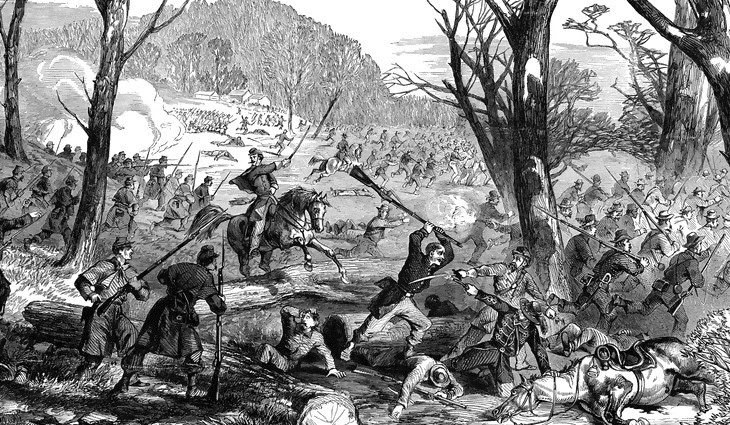The Battle of Camp Wildcat took place on October 21, 1861, in western Kentucky, the second engagement of the Civil War in that state of regular army troops representing both the Union and Confederacy.
What could have been a retreat against overwhelming odds turned into a Union victory due to the timely arrival of badly needed reinforcements.
Prelude
Despite being neutral, both sides saw the value of Kentucky in the war. For the Confederacy, control of Kentucky would offer a front line of defense should the Union invade eastern Tennessee; for the Union, control of the Bluegrass State would prevent the rebels from increasing the size of the Confederacy and gaining access to the Ohio River.
Both sides were actively recruiting new soldiers.
Confederate Brigadier General Felix Zollicoffer assumed command of a brigade in Bristol, Tennessee, in July 1861; from there, he began a movement through the Cumberland Gap into Kentucky along the Wilderness Road, then considered a major artery to the state's interior.
The object of the move was to control the road up to the town of Boonesboro, organize confused Confederate regiments, and prevent a Union invasion; control of the road also meant control of the mountain residents who were pro-union in sentiment.
At the same time, Theophilous Garrard, a grandson of a Kentucky governor who had just resigned his seat in the state senate to take an Army commission as colonel, was given command of a new Union regiment which at that time existed only on paper. Setting up a recruiting station near his hometown of Manchester, he managed to enlist nearly a thousand men by late August.

Beginning of the Battle
On September 9, Zollicoffer ordered his brigade north into Kentucky. By the 19th, his men held the Cumberland Ford near Pineville, Kentucky, and defeated a small Union force at Barbourville. By the 23rd, they were on the banks of the Laurel River near London.
Garrard, having just assembled his new regiment, was hastily ordered south along the Wilderness Road, with instructions that he was to guard a crossing point across the Rockcastle River; his camp was placed on a ridge three miles south of the crossing point, which he called Camp Wildcat.
None were properly outfitted, and his soldiers were hardly trained; in fact, little was taught beyond the proper firing of a musket, and one of them would die from a poorly handled weapon. A report he sent to his commander also included stragglers from the Laurel County Home Guard, routed by the Confederates on the Laurel River.
But the generally poor road conditions and lack of forage slowed Zollicoffer's regiment to little more than a crawl, allowing Garrard to entrench his men at Camp Wildcat while he sent dispatches urgently requesting uniforms, blankets, and, above all, reinforcements.
On October 19, Brigadier General Albin Scheopf was ordered to take command of Camp Wildcat, and he arrived late on the morning of the 20th; by then, Zollicoffer had managed to pass London and was now rapidly advancing towards Camp Wildcat.
But Garrard was no longer undermanned, for Scheopf had brought with him the reinforcements desperately needed: the 33rd Indiana Infantry, the 17th, 14th, and 38th Ohio infantries, and Battery B of the Ohio Light Artillery.
Battle and Aftermath

Early on the morning of October 21, men of the 17th and 29th Tennessee Infantries began making their way through the woods up towards Hoosier Knob, so named because it was an entrenched position held by four companies of the 33rd Indiana.
Firing began at about 9 a.m. and intensified within ten minutes. The 11th Kentucky Cavalry - sent with Garrard's company in the days before and just as green - dismounted on Hoosier Knob's right flank to join the fight; they would soon panic and attempt a retreat before cooler heads prevailed and rallied them. Behind the Hoosiers came the 14th and 17th Ohio Infantries, moving up to assist.
After thirty minutes of fighting, Confederate Colonel Tazwell Newman of the 17th Tennessee decided to order a charge up the hill to remove the Indiana and Ohio men. Although succeeding in reaching the parapet, the Confederates were low on ammunition and could not take control of the knob; Newman ordered them to fall back.
By afternoon, it appeared to Zollicoffer that he could not take Hoosier Knob, so he decided on an offensive up the more direct Wilderness Road towards the intersection of Winding Road, where Garrard had his headquarters.
Sending the 15th Mississippi Infantry and the 2nd Tennessee Cavalry - with artillery support - he attempted to break through Union lines but was stopped in another intense fight. Units from Hoosier Knob supported the remainder of the 17th Ohio and the entrenched Kentucky Home Guard; these men were reinforced by the timely arrival of the 38th Ohio and 1st and 2nd Tennessee infantries.
As the Bluecoats dug in, the attack they expected during the night and the next morning never came; Zollicoffer ordered a retreat, and his men fell back to Tennessee. Although a battle consisting of over 12,000 soldiers on both sides, casualties were few: 22 on the Union side versus 53 Confederates.
Disease, however, would claim more: the Union would state 71 men had died within weeks of measles and other illnesses, while hundreds would be incapacitated for several months; it is unknown how many Confederates died.
